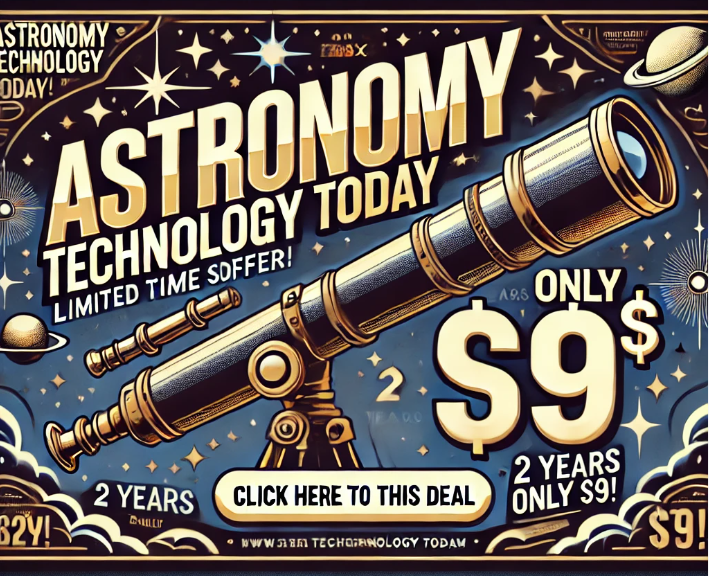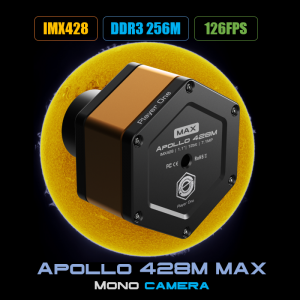 By Mark Zaslove
By Mark Zaslove
Mark Zaslove is a two-time Emmy Award winner and recipient of the coveted Humanitas Prize. Mark is a born-again astro noobie, who once had an Optical Craftsman scope as a kid, and is now recapturing his youthful enthusiasm (with a digital twist) and having a lovely time doing it.
 Sometimes, when ya gotta go big, ya gotta go big. This holds true for basketball, all-you-can-eat sundaes and binoculars. But big and comfortable? That can get a little bit more difficult. Past 70 millimeters, and handhelds get awkward, if not impossible, and the first time you crouch down to look towards the zenith with mounted binocs? You quickly realize how old you’re getting…fast. APM’s 100 mm 90° ED-Apo binoculars manage to be both big and comfortable to use, and with some nice glass to top it off (Image 1).
Sometimes, when ya gotta go big, ya gotta go big. This holds true for basketball, all-you-can-eat sundaes and binoculars. But big and comfortable? That can get a little bit more difficult. Past 70 millimeters, and handhelds get awkward, if not impossible, and the first time you crouch down to look towards the zenith with mounted binocs? You quickly realize how old you’re getting…fast. APM’s 100 mm 90° ED-Apo binoculars manage to be both big and comfortable to use, and with some nice glass to top it off (Image 1).
But first, what goes into these sleek gray puppies? 100 mm of -two-element air-spaced FK61 glass in a lightweight (for this sized binoc) magnesium alloy body that tallies 16.4 pounds sans eyepieces. And, hey, it can take pretty much any 1.25-inch-sized eyepieces (Image 2) – clear aperature at the eyepiece is 23 mm).
I didn’t catch any on-axis vignetting on it, and the eyeball-to-eyeball spread (interpupillary, for you big word peeps) is adjustable from 54 mm to 75 mm. Length, 555 mm, comes with a dewshield attached, has a focal length of 550 mm (f/5.5) and a max field of view (FOV) of about 2.8 degrees.
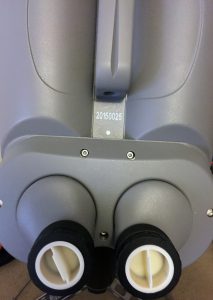 It’s got a couple of helical focuses that were smooth and easy to turn, but didn’t drift, with a photo adapter (3/8-inch thread) on the bottom and a handle at the top. And did I mention 90° angle to view? Of course I did; that’s the whole point. (See Image 3)
It’s got a couple of helical focuses that were smooth and easy to turn, but didn’t drift, with a photo adapter (3/8-inch thread) on the bottom and a handle at the top. And did I mention 90° angle to view? Of course I did; that’s the whole point. (See Image 3)
So, out to the dark site to take a gander. First rule of business: Find an appropriate mount; these binocs don’t take kindly to being shortchanged on stability. I used a TTS-160 Panther (Image 4) – giant binocs and gotos? Cool! – and away I went.
After having to forgo my usually place, I took to a spot on the side of the road and set up. For the record, I had a pair of 24 mm Panoptics, a pair of 11 mm Explore Scientific 82°-wides and a duo of 6 mm no-name Plossls.
First up, even before full darkness: The Moon. Did I mention how comfortable viewing through 90° angle binocs set on a perfect-height mount is? The Moon was a little less than first quarter and lower in the sky. I just leaned over the eyepieces a bit and voila!  Luna was sharp as a tack once dialed in, and with the barest hint of yellowish-green chromatic aberration on the leading edge.
Luna was sharp as a tack once dialed in, and with the barest hint of yellowish-green chromatic aberration on the leading edge.
This baby and these Pans gave a full view with a lot of space around to spare in the FOV. F/5.5 is really nice! Digging deeper with the 11 mm ES eyepieces showed an almost three-dimensional depth to the surface features, and settling down to a good long gander at the interplay between dark and light around the terminator kept me occupied till full night.
And then there was Jupiter. I love me some Jupiter. It’s endlessly fascinating to watch, and always gives a good show. In the APM binocs, it did not disappoint. Nicely colored bands in the Pans, and, of course the Galilean moons, all floating in some inky space. 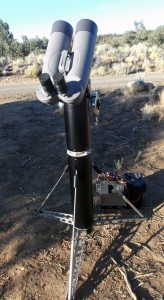 This was wide-field viewing in rare form. No real CA that I could tell. I cranked up the ES eyepieces and festoons and whirls began to dot the face of the gas giant.
This was wide-field viewing in rare form. No real CA that I could tell. I cranked up the ES eyepieces and festoons and whirls began to dot the face of the gas giant.
I started to lose the integrity of the image when the 6 mm Plossls were inserted. These are cheapie eyepieces, so I will make no comment on whether it was them or the binocs, but, suffice it to say, I didn’t use them the rest of the night. Planetary is cool, but these are still 100 mm apertures; time to view those things that were meant to be viewed: Ophiuchus and Scorpius and Sagittarius, oh, my!
Oh, be still my beating heart! Messier objects galore. M4 and the neighboring M80 were wonderfully globular (and throw in NGC 6144 as well). M 62, M19, the list goes on. Not just fuzzy circles, either, but, on the brighter clusters, discernment of individual stars away from the core. M6 and M7 were delicate and beautiful. Look, these binocs just ate up this section of the Milky Way, and it was just clouds of stars, clustered and dense. Colored and diamond, it was spectacular in the huge FOV of these things.
M8 and M20 were fine fuzzies that took form in the wide-field eyepieces, and M27, the Dumbbell Nebula, showed some nice 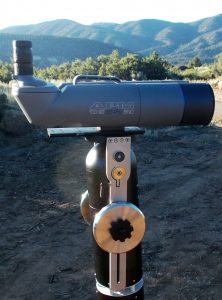 structure in the 11 mm ES eyepieces. I went for the Ring Nebula because, well, that’s what you have to do. Small but distinct, I could see it in both the 24 mm Pans and the 11 mm ES eyepieces without a problem. From there, I just kept sweeping the Milky Way, finding things, realizing what they were (NGC or Messier, or, whatever), and having a great night.
structure in the 11 mm ES eyepieces. I went for the Ring Nebula because, well, that’s what you have to do. Small but distinct, I could see it in both the 24 mm Pans and the 11 mm ES eyepieces without a problem. From there, I just kept sweeping the Milky Way, finding things, realizing what they were (NGC or Messier, or, whatever), and having a great night.
And at no time, with that 90° angle on the binocs, did I have a tough time viewing. Not once did I look and feel like a pretzel. No once did I have to crane my neck to get a view straight up. All other things being equal (and these binoculars don’t have a lot of equals), the 90° angle is a selling point. Even superior to the similar 45° version. Nope, 90° is the way to go for me.
In the end, the APM 100 mm 90° ED-Apo binoculars (Image 5) are a joy. They have a wonderful wide field, but take magnification well, solidly built, but light for their size, a hint of chromatic aberration, but completely manageable and only seen (by me) on the Moon and nowhere else. They are very reasonably priced as well at 2,990.00 US dollars, and, with that 90° angle, comfortable as all get-out!
If you’re thinking big, give Markus Ludes an email at APM to discuss with him (and my thanks to him for supplying the pair); he will answer any and all questions.
###
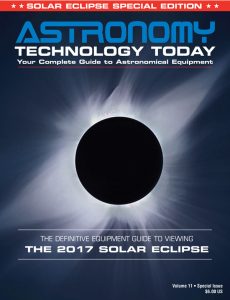 The Astronomy Technology Today editorial staff would like to take this opportunity to remind you of the availability of our Solar eclipse equipment guide – The Definitive Equipment Guide to the 2017 Solar Eclipse. Our goal with the 40 page publication is to provide an easy-to-consume introduction to the technological options for viewing and imaging the Great Solar Eclipse. We cover the gamut of options available including building you own solar viewer, solar glasses, smart phones, DSLR cameras, using astronomy telescopes, solar telescopes, using binoculars, solar filters (including a DYI filter option), CCD astro cameras, astro video cameras, webcams and much more. You can view the guide on our website here – its free and there is no requirement to sign up to read the guide.
The Astronomy Technology Today editorial staff would like to take this opportunity to remind you of the availability of our Solar eclipse equipment guide – The Definitive Equipment Guide to the 2017 Solar Eclipse. Our goal with the 40 page publication is to provide an easy-to-consume introduction to the technological options for viewing and imaging the Great Solar Eclipse. We cover the gamut of options available including building you own solar viewer, solar glasses, smart phones, DSLR cameras, using astronomy telescopes, solar telescopes, using binoculars, solar filters (including a DYI filter option), CCD astro cameras, astro video cameras, webcams and much more. You can view the guide on our website here – its free and there is no requirement to sign up to read the guide.


